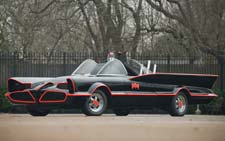












1966 Batmobile |
|||
| Classic and Hot Rod Cars And Their Stories | |||
| 1966 Batmobile | |||
In the low-budget 1943 "Batman" by Columbia Pictures, an unmodified 1939 Cadillac convertible was used as the vehicle of choice for both Batman and his alter ego Bruce Wayne. For the 1949 sequel, the filmmakers used a 1949 Mercury Convertible for Batman and Bruce. In 1955, the Lincoln division of Ford Motor Company designed and built a futuristic concept car called the Lincoln Futura, its rakish lines are said to have been inspired by the mako shark and the manta ray. It was built entirely by hand in Turin, Italy at a cost of $250,000, and like most concept cars, never put in production. Fast forward to August 1965, the Batman TV show producers approached George to have him build a new Batmobile for their upcoming show. The catch was the car had to be ready for action in a mere three weeks. Seeing the bat-like qualities his Futura already had, George felt it was the perfect answer to the quandary 20th Century Fox had created. In October of 1965, the Batmobile was born and television history was made... The 1960s Batman TV series featured the first on-screen appearance of a "true" Batmobile, based on the abandoned Lincoln Futura concept car which already shared many features with the comic book Batmobiles like the bubble canopy and fins. This two-seat Batmobile contained numerous gadgets, every one used in these films was fully functional, including the gas turbine powering the vehicle, which consumed fuel so fast there was only enough fuel capacity to run it for the approximately 15 seconds. The Batmobile's gadgets include a nose-mounted aluminum Cable Cutter Blade, Bat Ray Projector, Anti-Theft Device, Detect-a-scope, Batscope, Bat Eye Switch, Antenna Activator, Police Band Cut-In Switch, Automatic Tire Inflation Device, Remote Batcomputer—radio linked to the main Batcomputer in the Batcave, the Batphone, Emergency Bat Turn Lever, Anti-Fire Activator, Bat Smoke, Bat Photoscope, and more. Other devices included: Emergency Bat-turn Lever (releases the Batmobile's parachute that enables quick turns), Bat-ray (capable of many tasks, such as remotely opening quarry's vehicle doors), Automatic fire extinguisher, Mobile Batcomputer (in trunk), Bat Beam, Emergency tire inflator, Bat Smoke Screen Bat-tering Ram (also known as the Bat-ram, used for knocking down reinforced doors), Voice Control Batmobile Relay Unit, Bat-photoscope (works in conjunction with the Microfilm Crime File in the Batcave. Through this device a photo from the crime file can be reproduced remotely in the Batmobile.), Batphone, Police band cut-in switch, and Mobile tracking scope. If needed, the Batmobile is capable of a quick 180° "bat-turn" thanks to two rear-mounted ten-foot Deist parachutes. In late 1965 20th Century Fox Television and William Dozier's Greenway Productions contracted renowned Hollywood car customizer Dean Jeffries to design and build a "Batmobile" for their upcoming Batman TV series. He started customizing a 1959 Cadillac, but when the studio wanted the program on the air in January 1966, sooner than he could provide the car, he was paid off and the project went to George Barris. Barris was trying to get Hollywood's attention with the Futura, but aside from "It Started With a Kiss" in 1959, the Futura had been stored in his Hollywood shop for several years. With only three weeks to finish the Batmobile, Barris decided rather than building a car from scratch it would be relatively easy to transform the distinctive Futura into the famous crime-fighting vehicle. Design work was conducted by Herb Grasse working as an associate designer for Barris. Barris hired Bill Cushenbery to do the metal modifications to the car and its conversion into the Batmobile was completed in just three weeks, at a reported cost of US$30,000. They used the primer-painted, white-striped car in October, 1965, for a network presentation reel. Shortly afterward, the car was painted gloss black with "fluorescent cerise" stripes. The estimated 1966 value of the Barris Batmobile was about $125,000, but today it is estimated to be worth at least $2 million. When filming for the series began, several problems arose due to the age of the car: it overheated, the battery went dead, and the expensive Mickey Thompson tires kept blowing. By mid season, the engine and transmission were replaced with those of a Ford Galaxie. The most frequent visual influence of this car is that later Batmobiles usually have a rear rocket thruster that fires as the car makes a fast start. Barris built two fiberglass copies of the original Batmobile for exhibition on the car show circuit and a third for exhibition drag racing. Eventually, the three copies (and the TV show metal Futura Batmobile) were covered with a black velvet "fuzz" paint to hide stress cracks in the fiberglass bodies. Later, all were restored to their gloss black paint job. Barris retained ownership of the original television series car which is currently on display at Barris Customs in North Hollywood, California. The three Barris copies all reside in private collections, including the exhibition drag racing version driven by wheelstanding driver Wild Bill Shrewsberry. This car was built with a dual-quad Holman Moody Ford 427 V8 engine, Art Carr-prepared Ford C6 automatic transmission and a 5.14 rear end. Quarter-mile times were mid-12 second range, primarily because Shrewsberry would launch the car in second gear and smoke the overinflated rear tires for show down most of the strip. The "rocket exhaust" was made functional via a tank filled with either gasoline or kerosene which was pumped out the exhaust port and ignited electrically. |
|||
Note: All Images And Stories On This Site Are Copywrited. Use Of Any |
|||
 Great Pricing & Selection of Cameras and Accessories: Top Camera Mall |
|||
|
|||

